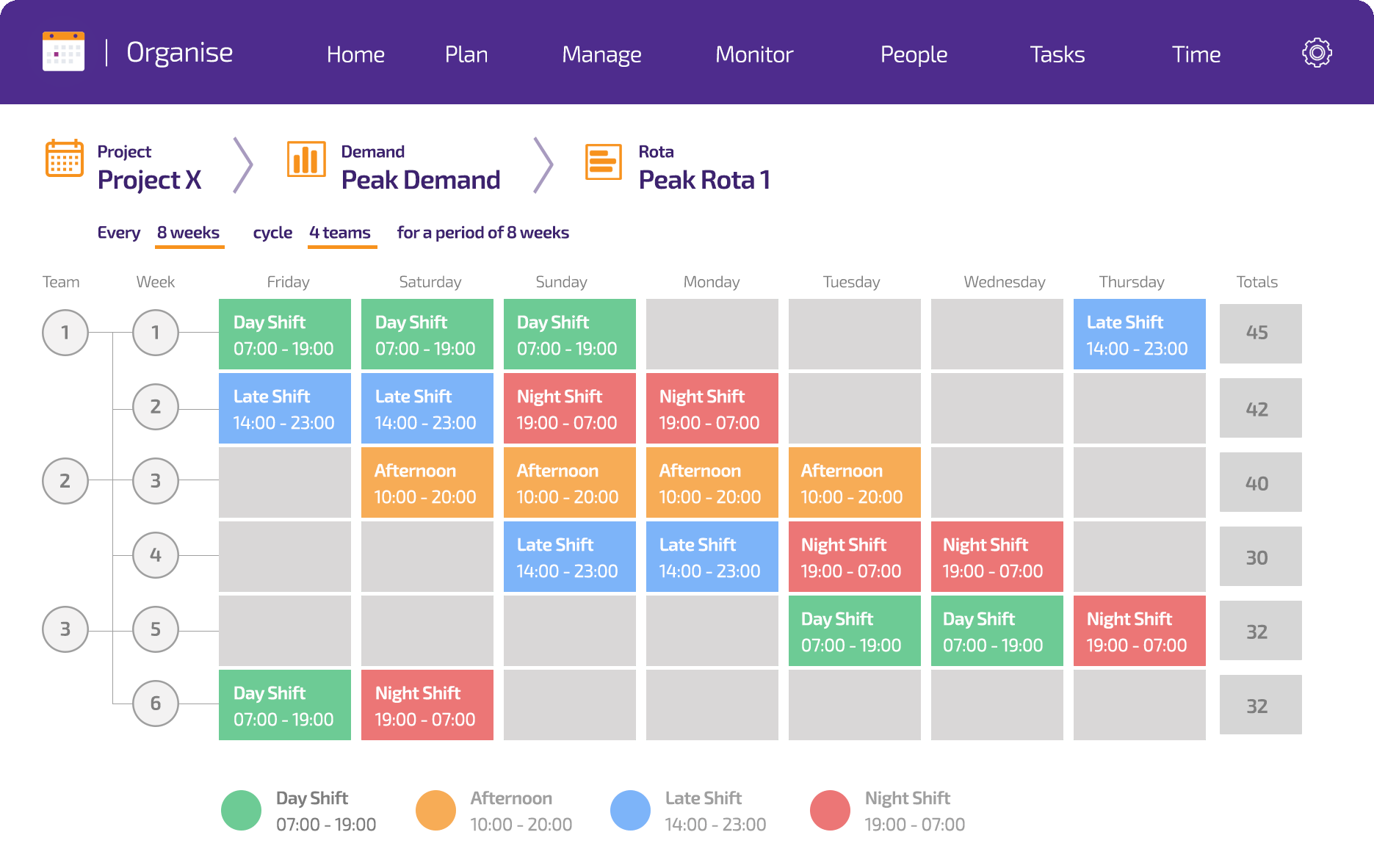Guide: 8 Vs 12 hour shift patterns
The great debate…

Longer Shift patterns – the Pros and Cons
- Shift extension: Working Time Regulations stipulate a minimum 11-hour difference between shifts. Theoretically, shift extensions on a 12-hour shift pattern are limited to 13 hours – this is before any compensatory rest period is taken into account.
- Missed shifts: If shifts are missed at short notice, the missed shift can be made up or ‘absorbed’ by extending an original 8 hour shift to 12 hours, extending the shift either side by 2 hours. This way, no replacement shift worker need be brought on site, as those already present provide the necessary cover. The reverse argument also applies: 8-hour shift patterns may incur back-to-backs (i.e. 16 hours total) and are not favourable.
- Cover: Employees’ willingness to cover a colleague’s shift pattern is variable, particularly when it comes to night shifts. Volunteers to provide replacement cover for a 12-hour long night shift may be scarce – it can be much easier to find cover for an 8-hour shift, even at night.
- White Space (time off between scheduled shifts at work): Extended ‘white space’ has repercussions in other areas. For example, longer spells between a shift worker being seen by a manager and greater consideration for re-connect time if a person has been inactive for a number of consecutive shifts. Lengthy shift patterns naturally accumulate more ‘white space’.
- Flexibility: Once working to a 12-hour shift pattern, employees are generally reluctant to move back to 8-hour shifts; the pay-off is simply too compelling. As a consequence, future changes will be harder to negotiate.
- Fatigue: Is the work physically or mentally demanding? What is the age profile of the workforce? There are a number of factors to be fully considered if shift pattern lengths are substantial and time between breaks limited.
- Days off: Number of weekends and days off are increased on a 12-hour shift pattern (note the figures in ‘Sample Rotas & Calculations’ section). There is also the potential to group days off and use ‘white’ space more effectively.
- Work-life balance: Reduced total travel (time and costs) result in reduced stress levels, allowing shift workers more quality time with their families and facilitate a healthy work-life balance. 12-hour shifts typically run 0600-1800, 1800-0600 and thereby facilitate ‘quality’ family evening time. There is also greater opportunity for shift workers to attend to their personal issues (e.g. doctor and dentist appointments, child care).
- Sickness: Because shift workers are more considerate of a colleague having to cover 12 rather than 8 hours, sick days are fewer. There is also proportionately more time off in a year for the sickness to fall into.
- Focus: During a run of shifts, 12 hours between shifts leaves little time for distractions after travel to/from home, meals and sleep. Hence minds are more focused on the task in hand.
- Consecutive days worked: Runs of shifts are shorter with longer shift patterns; consider typical runs of 3 or 4 shifts worked as 12 hours, versus say 5 shifts worked as 8 hours.
- Handovers: Fewer handovers between shifts results in:
- 1. Reduced downtime
- 2. Reduced opportunities for miscommunication
- 3. Reduced disruption to the rest of the workforce, with consequential impact on productivity
- 4. Reduced number of lock & tag changeovers where equipment isolations have been necessary (e.g. maintenance, blockage clearance)
- Increased productivity and ownership: Many shift workers spend the early part of their shift ‘getting up to speed’ / ‘settling things down’ / ‘tweaking & maximising’ – this is the ‘ramp’ period, which leads naturally into efficient working for the plateau (remainder of the shift). Assuming the ramp length is fixed, the plateau provides greater benefit for longer shift patterns. A longer shift pattern also provides more opportunity for job completion. Longer shift patterns therefore tend to instil a sense of accountability and completion.
- Risk and regulation: Fatigue risk is often associated with long shift patterns. Yet simulated studies have shown levels of fatigue in 8-hour shift workers and 12-hour shift workers to be comparable, concluding there to be no great increase in fatigue caused by working longer shifts.
The Health & Safety Executive (HSE) has made observations in relation to the subject of fatigue. It notes that fatigue can induce poor performance through reduced alertness, reaction time, concentration, and poor decision-making. The HSE also points out that tiredness can cause errors, accidents and injuries.
- Health and Safety at Work etc. Act 1974
- Management of Health and Safety at Work Regulations 1999
- Working Time Regulations 1998
- Other industry specific legislation (e.g. Railway and Other Guided Transport Systems [Safety] Regulations 2006; The Air Navigation [No. 2] Order 1995; etc.)
Arrange a session with one of our experts where you can discuss the challenges you face and talk in broad terms about potential solutions and next steps.

Indicies
Best practice
- Plan an appropriate and varied workload.
- Offer a choice of permanent or rotating shift patterns and try to avoid permanent night shifts.
- Rotate shifts every 2-3 days or every 3-4 weeks, otherwise adopt forward rotating shift patterns.
- Avoid early morning starts and try to fit shift times in with availability of public transport.
- Limit shifts to 12 hours including overtime, or to 8 hours if the work is demanding, monotonous, dangerous and/or safety critical.
- Encourage shift workers to take regular breaks and allow some choice as to when they are taken.
- Consider vulnerable shift workers.
- Limit consecutive working days to between 5 and 7 days and restrict long shifts, night shifts and early morning shifts to 2 or 3 consecutive shifts.
- Allow 2 nights full sleep when switching from day to night shifts and vice versa.
- Build regular free weekends into the shift schedule.
Conclusion

Arrange a session with one of our experts where you can discuss the challenges you face and talk in broad terms about potential solutions and next steps.







